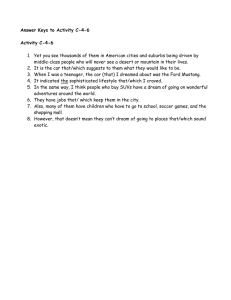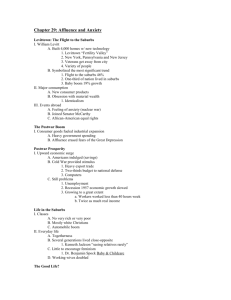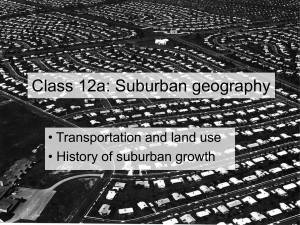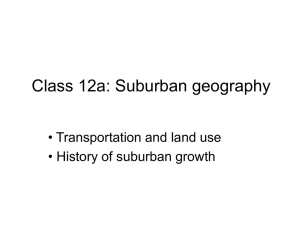Bibliography of Suggested Reading
advertisement
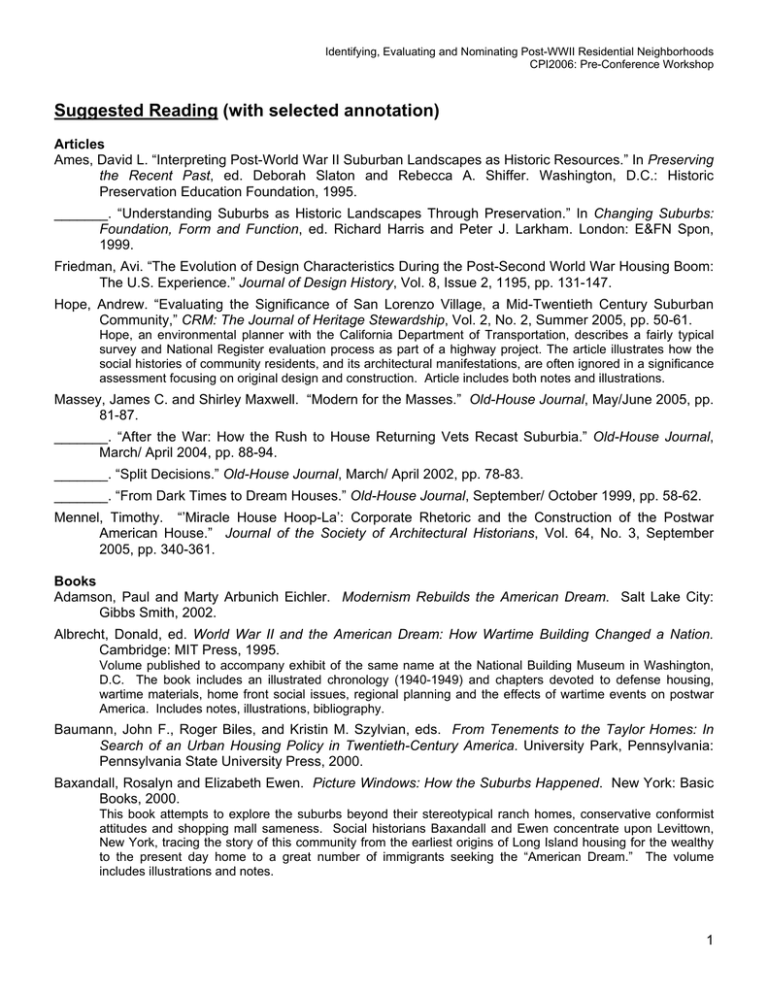
Identifying, Evaluating and Nominating Post-WWII Residential Neighborhoods CPI2006: Pre-Conference Workshop Suggested Reading (with selected annotation) Articles Ames, David L. “Interpreting Post-World War II Suburban Landscapes as Historic Resources.” In Preserving the Recent Past, ed. Deborah Slaton and Rebecca A. Shiffer. Washington, D.C.: Historic Preservation Education Foundation, 1995. _______. “Understanding Suburbs as Historic Landscapes Through Preservation.” In Changing Suburbs: Foundation, Form and Function, ed. Richard Harris and Peter J. Larkham. London: E&FN Spon, 1999. Friedman, Avi. “The Evolution of Design Characteristics During the Post-Second World War Housing Boom: The U.S. Experience.” Journal of Design History, Vol. 8, Issue 2, 1195, pp. 131-147. Hope, Andrew. “Evaluating the Significance of San Lorenzo Village, a Mid-Twentieth Century Suburban Community,” CRM: The Journal of Heritage Stewardship, Vol. 2, No. 2, Summer 2005, pp. 50-61. Hope, an environmental planner with the California Department of Transportation, describes a fairly typical survey and National Register evaluation process as part of a highway project. The article illustrates how the social histories of community residents, and its architectural manifestations, are often ignored in a significance assessment focusing on original design and construction. Article includes both notes and illustrations. Massey, James C. and Shirley Maxwell. “Modern for the Masses.” Old-House Journal, May/June 2005, pp. 81-87. _______. “After the War: How the Rush to House Returning Vets Recast Suburbia.” Old-House Journal, March/ April 2004, pp. 88-94. _______. “Split Decisions.” Old-House Journal, March/ April 2002, pp. 78-83. _______. “From Dark Times to Dream Houses.” Old-House Journal, September/ October 1999, pp. 58-62. Mennel, Timothy. “’Miracle House Hoop-La’: Corporate Rhetoric and the Construction of the Postwar American House.” Journal of the Society of Architectural Historians, Vol. 64, No. 3, September 2005, pp. 340-361. Books Adamson, Paul and Marty Arbunich Eichler. Modernism Rebuilds the American Dream. Salt Lake City: Gibbs Smith, 2002. Albrecht, Donald, ed. World War II and the American Dream: How Wartime Building Changed a Nation. Cambridge: MIT Press, 1995. Volume published to accompany exhibit of the same name at the National Building Museum in Washington, D.C. The book includes an illustrated chronology (1940-1949) and chapters devoted to defense housing, wartime materials, home front social issues, regional planning and the effects of wartime events on postwar America. Includes notes, illustrations, bibliography. Baumann, John F., Roger Biles, and Kristin M. Szylvian, eds. From Tenements to the Taylor Homes: In Search of an Urban Housing Policy in Twentieth-Century America. University Park, Pennsylvania: Pennsylvania State University Press, 2000. Baxandall, Rosalyn and Elizabeth Ewen. Picture Windows: How the Suburbs Happened. New York: Basic Books, 2000. This book attempts to explore the suburbs beyond their stereotypical ranch homes, conservative conformist attitudes and shopping mall sameness. Social historians Baxandall and Ewen concentrate upon Levittown, New York, tracing the story of this community from the earliest origins of Long Island housing for the wealthy to the present day home to a great number of immigrants seeking the “American Dream.” The volume includes illustrations and notes. 1 Identifying, Evaluating and Nominating Post-WWII Residential Neighborhoods CPI2006: Pre-Conference Workshop Bennett, Michael J. When Dreams Came True: The GI Bill and the Making of Modern America. Washington, DC: Brassey’s, Inc., 1996. Bennett discusses the role of the GI Bill in stimulating the post W.W.II housing boom. He focuses not only on the important provision of the bill providing for guaranteed mortgage loans for veterans, but also places the bill within the larger context of America’s treatment of its returning war veterans. Beuka, Robert. SuburbiaNation: Reading Suburban Landscape in Twentieth-Century American Fiction and Film. New York: Palgrave Macmillan, 2004. Birnbaum, Charles A., Jane Brown Gillette, and Nancy Slade, eds. Preserving Modern Landscape Architecture II: Making Postwar Landscapes Visible. Washington, D.C.: Spacemaker Press, 2004. Cohen, Lizbeth. A Consumers’ Republic: The Politics of Mass Consumption in Postwar America. New York: Knopf, 2003. Colomina, Beatriz et al., eds. Cold War Hothouses: Inventing Postwar Culture from Cockpit to Playboy. New York: Princeton Architectural Press, 2004. Dietsch, Deborah. Classic Modern: Mid-Century Modern at Home. New York: Simon & Schuster, 2000. Duany, Andres, Elizabeth Plater-Zyberk and Jeff Speck. Suburban Nation: The Rise of Sprawl and the Decline of the American Dream. New York: North Point Press, 2000. Eichler, Ned. The Merchant Builders. Cambridge: MIT Press, 1982. Book offers unique perspective from individual who worked for the two firms most associated with postwar housing development. Eichler, the son of Joseph Eichler, worked as a sales associate for the family firm and then worked for Levitt and Sons in the 1970s. Fishman, Robert. Bourgeois Utopias: The Rise and Fall of Suburbia. New York: Basic Books, 1987. Goldstein, Carolyn M. Do It Yourself: Home Improvement in 20th –Century America. New York: Princeton Architectural Press, 1998. This catalog for an exhibit at the National Building Museum in Washington, DC, offers a brief overview of the do-it-yourself movement that came to fruition in the post-World War II era. What had been an activity of necessity in the late nineteenth and early twentieth centuries became a hobby and passion for American homeowners. Shelter and self-help magazines and books fed the movement, while tool and building products manufacturers revamped their offerings for the non-professional and building supply centers tailored their stores for mass merchandising. Goldstein discusses the significant influence of stereotypical gender roles in early do-it-yourself advertising and merchandising and how these notions of domesticity changed over time. The volume is heavily illustrated with period magazine covers and advertisements, most in color. Also includes notes and bibliography. Gutman, Robert. The Design of American Housing: A Reappraisal of the Architect’s Role. New York: Publishing Center for Cultural Resources, 1985. Hardwick, M. Jeffrey. Mall Maker: Victor Gruen, Architect of an American Dream. Philadelphia: University of Pennsylvania Press, 2004. Architect Victor Gruen designed several hundred buildings and city plans, and authored four books plus hundreds of articles constituting a body of architecture and architectural ideas nearly unequaled in its breadth and impact. During his mid-twentieth century career, he popularized several innovations-- store modernization, enclosed shopping centers, and downtown pedestrian malls. His Southdale Shopping Center in Edina, Minnesota, is considered to be the nation’s first indoor shopping mall. Hardwick concludes that Gruen’s life is a study of conflicting ideas and actions: he hated the automobile but always catered to it; he brought Main Street to the suburbs and yet lamented the destruction of downtowns; he expressed concerns about soulless shopping centers devoted to retailing, yet he always worked as a commercial architect; he wanted to build spaces for people but instead built larger and larger spaces for private corporations. The landscape of modern urban America, good and bad, owes much to the practice and influence of Victor Gruen. Hayden, Dolores. Building Suburbia: Green Fields and Urban Growth, 1820-2000. New York: Pantheon Books, 2003. This book offers solid historical background about the development of suburbs over time: enclaves, railroad suburbs, streetcar suburbs, post-World War II suburbs (which Hayden refers to as ‘sitcom suburbs’), nodes, rural fringe and new urbanism. The author explores the relationship of developers and government to define 2 Identifying, Evaluating and Nominating Post-WWII Residential Neighborhoods CPI2006: Pre-Conference Workshop real estate transactions and the built environment. Hayden is an ardent anti-sprawl advocate who urges historic preservation instead of New Urbanism. The volume includes illustrations, notes and bibliography. Hennessy, William J. Vacation Houses. New York: Harper & Brothers, 1962. Hess, Alan. The Ranch House. New York: Harry N. Abrams, 2004. This large, coffee table book has great pictures of both interiors and exteriors of the ubiquitous Ranch house. Beginning with three chapters of background and early builders, the remainder of the book looks at individual Ranch houses in California, Arizona, and Texas. Captions for each image provide additional information. Notes, a select bibliography, and an index round out this useful resource. Hine, Thomas. Populuxe: The Look and Life of America in the ‘50s and ‘60s. New York: Alfred A. Knopf, 1987. The subtitle of this book, from tailfins to TV dinners to Barbie dolls and fallout shelters, announces the popular culture emphasis of this volume. For Hine the Populuxe period, roughly from 1954 to 1964, was the moment when Americans discovered how to turn out fantasy on an assembly line. Key chapters cover houses, interior design, cars, design motifs, appliances and space-age styling. The volume includes numerous illustrations (many from advertisements). Hitchcock, Henry-Russell and Arthur Drexler, eds. Built in the USA: Post-war Architecture. New York: Museum of Modern Art, 1952. Hunter, Christine. Ranches, Rowhouses, and Railroad Flats—American Homes: How They Shape Our Landscape and Neighborhoods. New York: W.W. Norton, 1999. Hurley, Andrew. Diners, Bowling Alleys, and Trailer Parks: Chasing the American Dream in Postwar Consumer Culture. New York : Basic Books, 2001. Ierley, Merritt. The Comforts of Home: The American House and the Evolution of Modern Convenience. New York: Clarkson Potter, 1991. Jackson, Kenneth T. Crabgrass Frontier: The Suburbanization of the United States. New York: Oxford University Press, 1985. Jester, Thomas C., ed. Twentieth-Century Building Materials: History and Conservation. New York: McGraw-Hill, 1995. Kaledin, Eugenia. Daily Life in the United States, 1940-1959. Westport, Connecticut: Greenwood Press, 2000. Kelly, Barbara M. Expanding the American Dream: Building and Rebuilding Levittown. New York: State University of New York Press, 1993. Much has been written about the building of Levittown, Long Island – perhaps too much. Kelly covers familiar territory in her history of the post-World War II conditions that came together so effectively at Levittown– the generous VA and FHA loan programs; the federal standards for minimum single-family housing; the cult of domesticity; the pent-up demand for housing by newly established families of ex-servicemen; the new building materials and processes perfected in wartime production; and the vision of the Levitts (among others) to seize upon these conditions as a golden business opportunity. What sets Kelly’s treatment apart is her focus on the families who lived in Levittown, both its original renters and owners (the “pioneers”) as well as those who became second and third-generation Levittowners. She demonstrates through personal interviews and architectural analysis how residents took the basic Levitt Cape Cod Revivals and Ranches and modified and expanded their houses to better meet family needs over time. The blending of social and architectural history provides more depth and substance to this study than is found in the typical architectural critique or sociological criticism of suburbia. Book includes illustrations, notes, bibliography and index. Lewis, Robert D. Manufacturing Suburbs: Building Work and Home on the Metropolitan Fringe. Philadelphia: Temple University Press, 2004. Martinson, Tom. American Dreamscape: The Pursuit of Happiness in Postwar Suburbia. New York: Carroll & Graff Publishers, 2000. Martinson is an experienced planner and architect with a particular interest in the development of American suburbs. He demonstrates suburbia dates to the late nineteenth century. Diversity is a major theme, in suburban residential classes (nobility, gentry and yeomen), in architectural styles, in transportation orientation, 3 Identifying, Evaluating and Nominating Post-WWII Residential Neighborhoods CPI2006: Pre-Conference Workshop in landscape treatment, and planning concepts. He criticizes the New Urbanism movement for its lack of historical perspective, its urbanist assumptions, and its anti-automobile mantra. Mason, Joseph B. History of Housing in the U.S.: 1930-1980. Houston: Gulf Publishing, 1982. Matheson, Whitney. Atomic Home: A Guided Tour of the American Dream. Portland, OR: Collectors Press, Inc., 2004. This brisk and breezy overview provides a nostalgic look at the so-called “atomic home,” the American suburban house built between the end of World War II and the “swingin’ 1960s.” The volume is light on text and heavy on full-color advertising images. Organized around the rooms in the “typical” suburban house, additional chapters are devoted to outdoor maintenance and outdoor recreation. Strangely missing is the popular family or “rec room” of the period. While the images are fun to peruse, the accompanying text most often ignores the illustrations and highlights related products or popular trends. The introductory material is all too brief for those with a serious interest in the subject. The occasional error of fact (“…Levitt constructs the first American suburb…”) and the advertiser/manufacturer origin of the illustrations limit the usefulness of the presentation. Still, the images alone are worth the price of admission to see how select advertisers promoted the “American dream” in the 1950s. May, Elaine Tyler. Homeward Bound: American Families in the Cold War Era. New York: Basic Books, 1988. Much of this text is based upon information from the Kelly Longitudinal Study, a series of annual surveys from 600 white middle-class men and women who formed families in 1940s. Chapters provide overviews of key sociological topics such as gender, sexual activity, marriage, family life, consumerism. Volume includes illustrations, notes and appendices with information related to the Kelly Study responses. Moore, Eugene. Inspiring 1950s Interiors. Atglen, Pennsylvania: Schiffer Publishing, 2005. Nelson, George and Henry Wright. Tomorrow’s House. New York: Simon and Schuster, 1946. Randall, Gregory C. America’s Original GI Town: Park Forest, Illinois. Baltimore: Johns Hopkins University Press, 2000. Randl, Chad. A-frame. New York: Princeton Architectural Press, 2004. Well-illustrated history of the A-frame, focusing on the 1950s and 1960s but tracing the development through earlier time periods and diverse cultures and up to the present day. Examples shown and discussed include houses, churches, restaurants, stores, and even toy houses. Stresses social and cultural factors in the spread of this architectural form, including the role of marketing and advertising. Rose, Kenneth D. One Nation Underground: The Fallout Shelter in American Culture. New York: New York University Press, 2001. The fallout shelter came from early Cold War civil defense concerns for the survival of the civilian population in time of nuclear war. Arguments quickly arose over the practicality, the expense, the patriotism, and the physiological affects of a massive fallout shelter building program, both public and private. Rose concludes that the late 1950s and early 1960s generated much talk but little actual construction. Ultimately, the moral questions of who would be saved and who would make that decision were trumped by the growing power of nuclear weapons, which left the fallout shelter as an ineffective tool but a powerful icon of the period. Rosenbaum, Alvin. Usonia: Frank Lloyd Wright’s Design for America. Washington, DC: Preservation Press, 1993. This book focuses mainly on the philosophy behind Frank Lloyd Wright and his ideas regarding the Usonian house. The author however provides a unique perspective having grown up in a Wright-designed Usonian house in Alabama. Great pictures help show the simple beauty of these modern houses Wright saw as a solution to society’s housing problem. Sherfy, Marcella and W. Ray Luce. Guidelines for Evaluating and Nominating Properties that Have Achieved Significance Within the Past Fifty Years, revised edition. National Register Bulletin. Washington, D.C.: U.S. Department of Interior, National Register, 1998. Spigel, Lynn. Welcome to the Dreamhouse: Carolina: Duke University Press, 2001. Popular Media and Postwar Suburbs. Durham, North Wachs, Martin and Margaret Crawford. The Car and the City: The Automobile, the Built Environment and Daily Urban Life. Ann Arbor: University of Michigan Press, 1992. 4 Identifying, Evaluating and Nominating Post-WWII Residential Neighborhoods CPI2006: Pre-Conference Workshop Walker, Peter and Melanie Simo. Invisible Gardens: The Search for Modernism and the American Landscape. Cambridge: MIT Press, 1994. Wallis, Allan D. Wheel Estate: The Rise and Decline of Mobile Homes. New York: Oxford University Press, 1991. Webb, Michael. Modernism Reborn: Mid-Century American Houses. New York: Universe Publishing, 1989. Weiss, Marc A. The Rise of the Community Builders: The American Real Estate Industry and Urban Land Use Planning. New York, NY: Columbia University Press, 1987. Wiseman, Carter. Shaping a Nation: Twentieth-Century American Architecture and Its Makers. New York: Norton, 1998. Wright, Esmond. The American Dream: From Reconstruction to Reagan. Cambridge, Massachusetts: Blackwell Publishers Inc., 1996. Wright, Gwendolyn. Building the Dream: A Social History of Housing in America. New York: Pantheon Books, 1981. Yenne, Bill. Going Home to the ‘50s. San Francisco: Last Gasp, 2002. Survey Reports Marmor, Jason. Historic Preservation Feasibility Study: Broomfield Heights First Filing and Original Broomfield- DRAFT. Fort Collins, Colorado: RNL Design, 2001. Thomas, Adam and Timothy Smith. Suburban Development: Greeley’s Arlington Neighborhood Survey Report. Westminster, Colorado: SWCA Environmental Consultants, 2004. [WL.SHF.R28] Theses and Dissertations Richardson, David John. Ranches to Ranch Houses: Suburbanization in Metropolitan Denver. University of Colorado at Denver, 2004. M.A., Websites Denver Modern Homes: http://denvermodern.mariah.com A real estate site, but good for getting views of interiors of 1950s and 1960s homes for sale. Eichler Network: www.eichlernetwork.com Comprehensive site with wide range of historical articles about Eichler homes. Levittown (PA): Building the Suburban Dream: http://server1.fandm.edu/levittown/one/c.html State Museum of Pennsylvania site with historical background and numerous photographs and other visuals. Levittown (NY) Historical Society: www.levittownhistoricalsociety.org/welcome.htm Includes links to Levittown History, Museum Store and Museum Tour LottaLiving: www.lottaliving.com Your source for Mid Century Modern Lifestyle, Design, Art, Furniture and Architecture Mile High Modern: www.milehighmodern.com Denver metropolitan area real estate listings, brief history of modernism in city, links The Recent Past Preservation Network: www.recentpast.org Promoting preservation education and advocacy to encourage a contextual understanding of our modern built environment. Includes links to an illustrated glossary of architectural terms, newsletter and the national windshield survey. Split-Level Home Network: www.splitlevel.net Celebrating the Versatility and Value of Bi-Level, Split-Level and Raised Ranch Homes. Includes architectural descriptions, historical background and renovation ideas 5
